https://www.youtube.com/watch?v=sYfDV209V14
How To Butcher Every Bird _ Method Mastery _ Epicurious
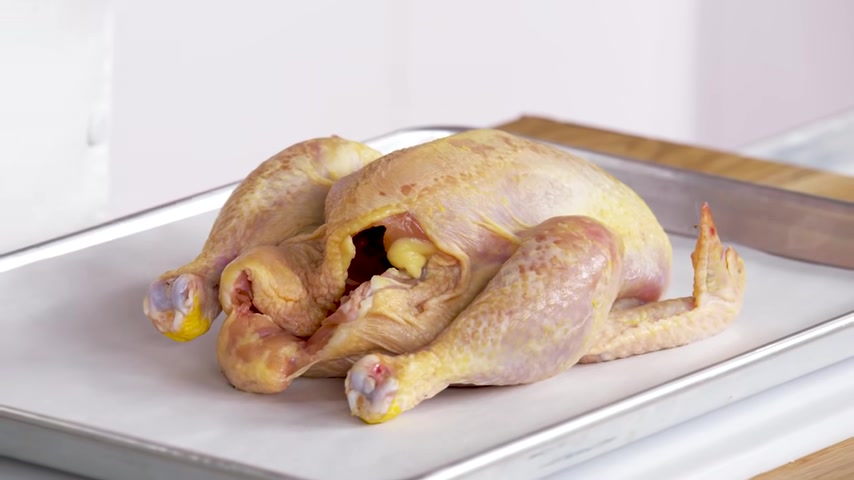
Crack it apart .
It's gonna get fuck in here .
I'm Frank , I'm a chef instructor at the Institute of Color Education .
And today I'm gonna show you how to butcher every bird chicken .
This chicken's about £3 .
We call that a fryer because usually the parts are broken down for frying .
This is what you will see .
People cut up for parts in a supermarket so you can see that our chicken has some really nice yellow skin .
There's also some little spots on here .
This chicken has been in the fridge uncovered for a little while and what's happening is that the skin is drying out .
This isn't a bad thing .
If you're gonna roast the whole bird , you should leave it uncovered and it dry out for a day .
So you get some really nice crisp skin .
The knife I'm using for , this is a stiff or a firm boning knife .
It doesn't bend , it's not super flexible .
It's got a long thin sharp blade and a nice pointy tip .
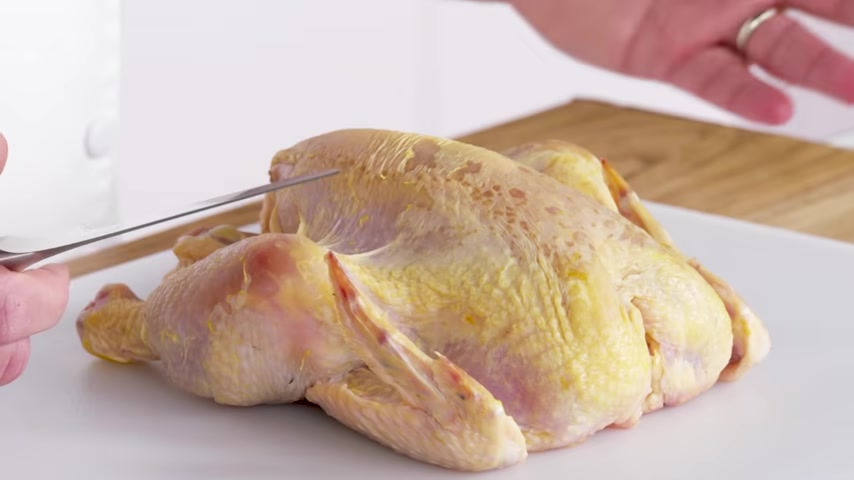
So you can get in and out of the nooks and crannies , you can cut in tight spots .
So we're gonna portion this chicken out to eight pieces .
And I usually start with the wings .
I'm going to grab it and the wing naturally goes like this .
So I'm gonna pull it unnaturally out of where it usually goes .
There's a little kind of V here , I'm gonna take my knife and just cut into that V .
You can see that's where the joint is .
I'm gonna spin it around .
So I don't get any breast meat and I'm just going to cut that off nice and easy turn the bird around right where the joint meets , right ?
Go around it .
Try not to get any breast meat and that's how my other wing comes off .
Next thing I'm gonna do is take off the legs and the legs have some skin here that attaches to the breast .
So I'm just gonna kind of go as high up as possible .
So that , that skin kind of lays on the breast , right ?
There's also like a little hip bone here .
I'm just gonna kind of cut under that bone , right .
So you can see protrudes up , I cut under it , right .
Finish taking the skin off , do the other side as well .
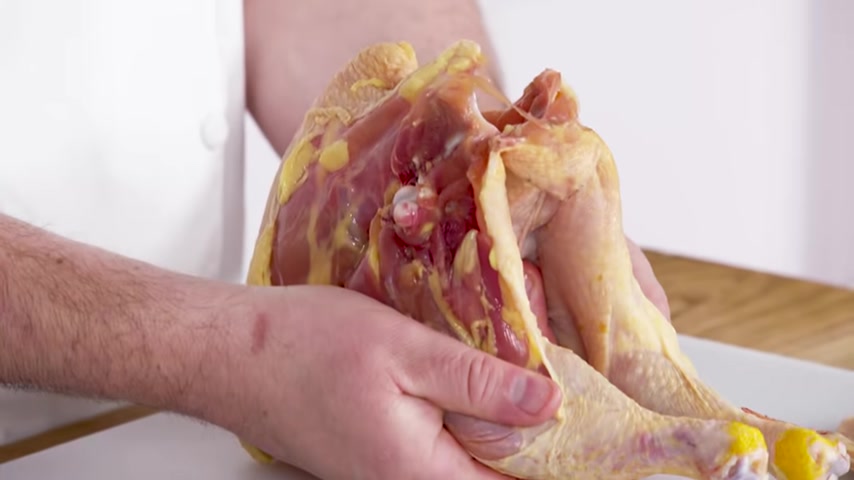
Pick the bird up and pop out the joints .
If I turn the bird over and I hold it up like this , you can see there's like a clear yellow patch in the middle , but you can also see underneath the skin , you can see where the flesh is .
There's two little pieces of flesh here those are called the oysters .
They're delicious .
You when you're carving a bird up that's been roasted .
Those are the chef's treat .
Most people don't know about the oyster .
Your grandmother probably does because she's the one that's been eating them all along .
What I like to do is I like to hold the bird up like this .
Put the back of my knife rests on the bone .
Once I get to that joint , I jog in and I scoop that oyster out , turn it over and then trim it up , get the skin off .
And that's my first let same thing here , jog in where the oyster is and then cut my other leg off .
And now we're gonna take the breast off and I'm gonna try and leave the skin intact because if we're gonna cook this with the skin , we want it to be covering the whole breast .
I feel for the breast bone here .
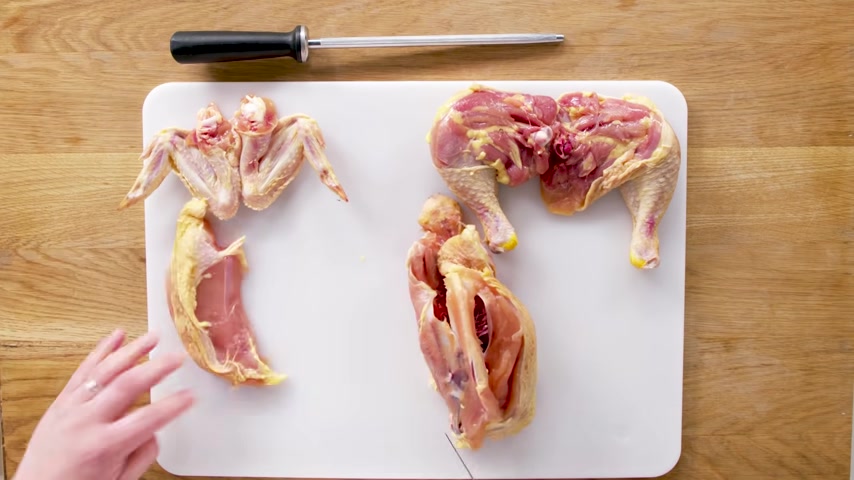
And I'm just gonna cut on either side of the breast bone , cut all the way down to the wish bone .
And I'm just gonna run the back of my knife along the bones and the breast comes right off , spread out your skin .
So it covers same thing with this .
And we have our nice breast there and our chicken carcass .
Sometimes you'll get French chefs that , tell you to pull off the wishbone before you cut it because it's some meat here .
I find that the time it takes me to pull that wishbone out and to save maybe an ounce and a half of meat , I'd much rather just put this in my stock pot because in the restaurant you're always trying to conserve with our chicken breast , we could easily just saute this and sear with the skin on and serve it like that .
But what I'm gonna do is I'm going to make this into cutlets .
I'm just gonna peel the skin back , get off any excess fat .
And then I'm gonna butterfly this cut kind of halfway through and then open it up and it said the butterfly because it looks like a butterfly and we can pound this out and use it for cutlets with our tender .
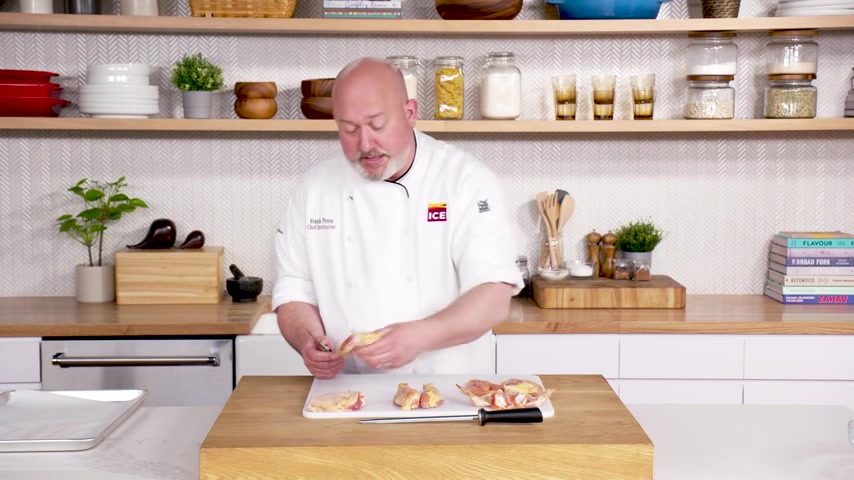
If you hold on to this little piece of connective tissue here , you can just pull it out , get rid of that and you can make chicken tenders for the kitties with this one for our legs and thighs .
There's a line of fat between the leg and the thigh .
I go on that line of fat and just move my knife towards the leg slightly about an eighth of an inch and you'll always find the joint .
So there's my thigh on the other side , you gotta go the opposite way .
Then there's our legs .
These thighs are really great for grilling or you can stew them or braise them .
But what I like to do is debone them .
Sometimes I take off the skin first .
I get my thigh .
I lay it down on the skin side and then I pull the meat away with my two fingers .
The tip of the knife goes in , I'm using the back of the knife resting on the bone and I basically trace the bone .
Then I pinch and pull off the bone .
If there's any sort of connective tissue there , I get rid of it .
And that is my bone with thigh 2468 , we've cut our chicken into eight portion pieces and this is my chicken .
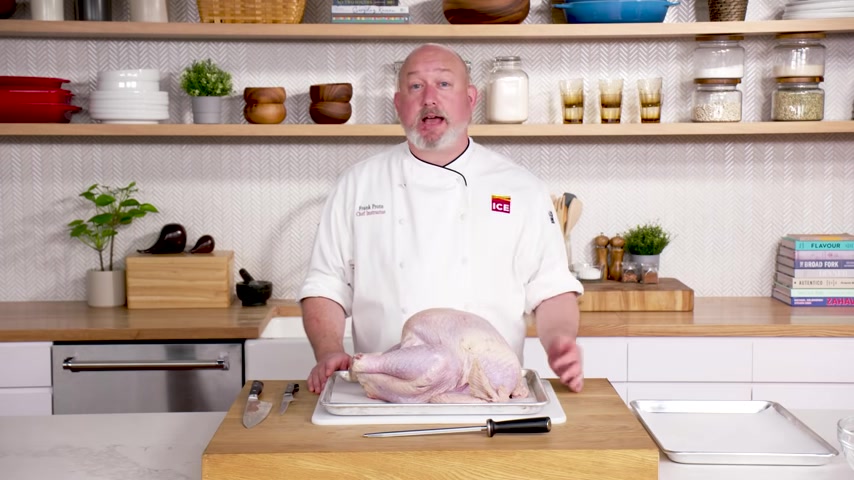
Turkey .
Turkey is a very common bird in America .
I live in Connecticut .
These things are mean bastards .
They will come after you , but they're delicious .
Today , we're gonna spatchcock it and basically spatchcock means we're gonna take out the backbone and flatten it .
Not only does it fit in the oven better , it also cooks a little quicker than if you were to cook it whole .
And you get a little bit more of a juicy result with the breast .
It's not as dry and shredding like , you know , and Josie's used to be or whatever , we're gonna use a larger knife , which is a chef knife .
It's obviously bigger than our bony knife .
It gives you a little more leverage .
I don't want to slip and I don't want to cut myself .
And basically , what I'm gonna do is I'm gonna hold the thigh for the most part .
I should be able to cut down the backbone here and the bones aren't super hard there , but I don't want you to hurt yourself .
Ok ?
You never really want to cut towards yourself with this , right .
So we cut one side of the spine .
You can take that piece off grandma's favorite , turn it around and you can go the opposite way , make sure you get past that thigh bone and we'll go through it here .
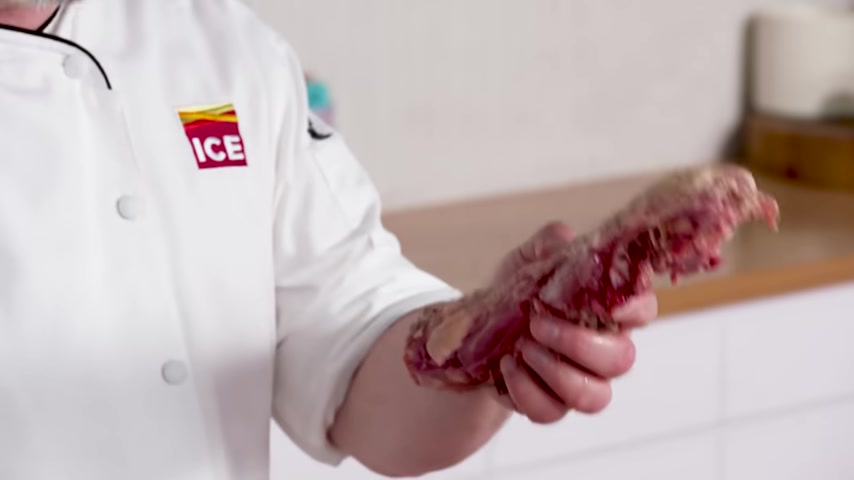
So once you remove the spine , do not throw this away any excess bones or skin that you have put in your stock pot , make a turkey stock .
Even if you're not gonna use it now , you can freeze it .
It holds really well .
So we open up our turkey .
I'm gonna just make a little bit of an incision here .
There's a piece of cartilage here .
Great .
I'm just gonna kind of nip it so that this opens up better .
I'm gonna turn this around because I have to put more pressure on this side when you flatten it out .
Be careful not to cut yourself .
There's some sharp bones here flatten this sucker out .
You can even put a towel on this if you want to .
And basically what we're gonna do is we're gonna expose this keel bone here .
Let me flip it over , do a little more push .
Give it the old CPR .
That's it .
Spatchcock Turkey .
Now that we flatten this out , it's gonna cook much more evenly .
You can pretty much do anything with this .
You can grill it , roast it .
You can probably deep fry it .
Don't bring your house down , please .
Normally , by the time the legs are cooked , the breast is dried out .
When we do it .
This way , they cook a little quicker .
They cook a little more evenly and you're gonna get a more juicy breast .
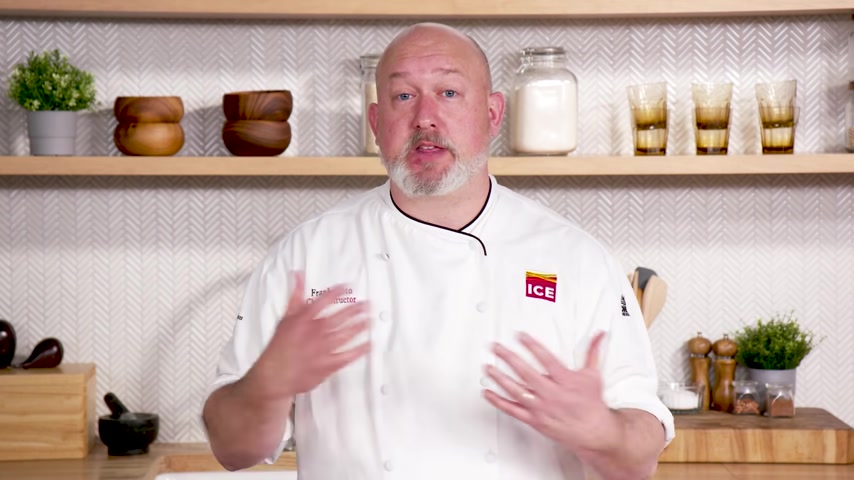
Duck .
Duck is a farm raised bird .
That's a little more gamey when I'm thinking of birds .
And I think of gay , I think of animals that are in the wild .
They're eating where they can get their little beaks on .
It's not like this , this measured out diet that you would get in a farm raised animal .
And usually that starts out with a very lean meat that's dark , that has kind of an iron flavor in the beginning or a livery flavor .
And then in the back , once you swallow it , you get this like kind of barnyard y funk duck has a really deep red meat that is more similar to a steak than maybe a chicken breast .
We're gonna quarter this duck break the duck down into its two breasts , which we're going to score and use for sauteing and the legs for con con is basically , you're taking the legs , you're gonna salt them and put some herbs and spices on them and you're gonna cook them in duck fat .
And I usually just face the duck towards me .
The duck has a really nice exposed kind of breast bone there .
You can see it .
I'm gonna cut on either side of this .
Just move the skin away .
Duck has really fatty skin .
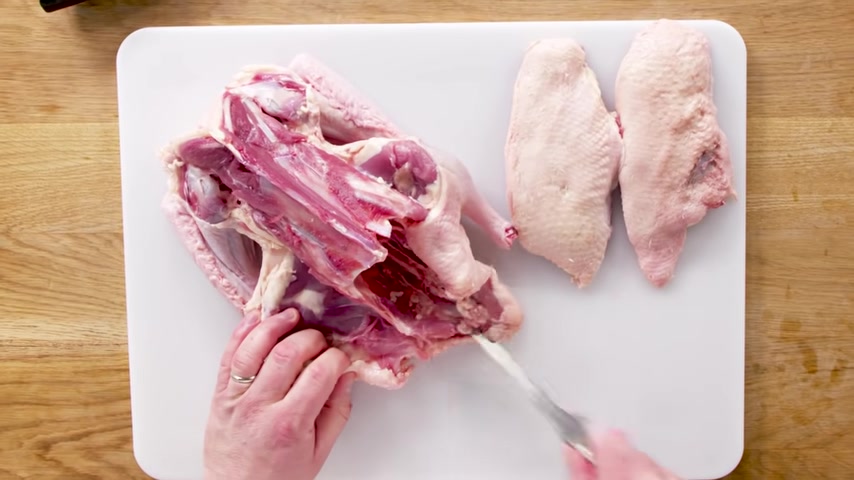
So when you cook it , you wanna cook it skin side down and render , get all that fat out , right ?
So all I'm gonna do is take my knife , rest the back of my knife on the wish bone and the back of my knife rests on all the bone here .
I'm not even gonna worry about the wings .
I guess you can cook them like chicken wings .
But for the most part , uh I'm only using it for uh stop .
So there's my first duck breast , take the second one off , just run my knife along that wish bone , cut the skin .
And I'm really more worried that the skin is on the breast than on the thigh .
So the breasts are both off .
We're also going to now take the legs and thighs off together .
I'm just gonna cut straight down .
There's a little hip bone here basically run the part of the knife facing me on the hip bone , do that on that side .
It freeze open the legs and thighs , pop out the joints and I'm just gonna cut , make sure you get your oyster there .
The legs come off .
Now , what's the good thing about a duck is that it has a lot of fat .
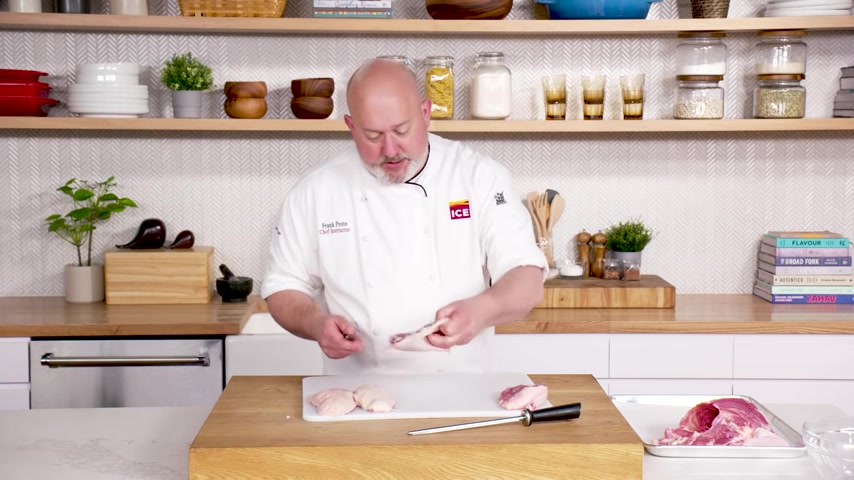
So I will collect all the little pieces of fat and I'm gonna put this in a pot with a little bit of water and I'm gonna render out all the fat from it .
So that when I make my feet , I have duck fat put that aside .
There's a ton of fat on the inside of the legs here .
So I'm gonna trim the legs up again .
I'm gonna save that fat .
Use it to render , try to make the legs look really nice .
So for the comfy , we'll take the knife , we go around .
So as we cook , this will shrink down a little , this little joint here , uh will come right off and we'll have a nice clean .
Look when we actually cook this for our breasts .
I wanna make these nice and even so I'm just gonna trim off any excess fat again , save the excess fat and skin and then what you can do to facilitate us rendering that duck fat out and getting some nice crispy skin is you can score this .
If you kind of par , freeze this a little , if you get it ice cold , it's a little easier .
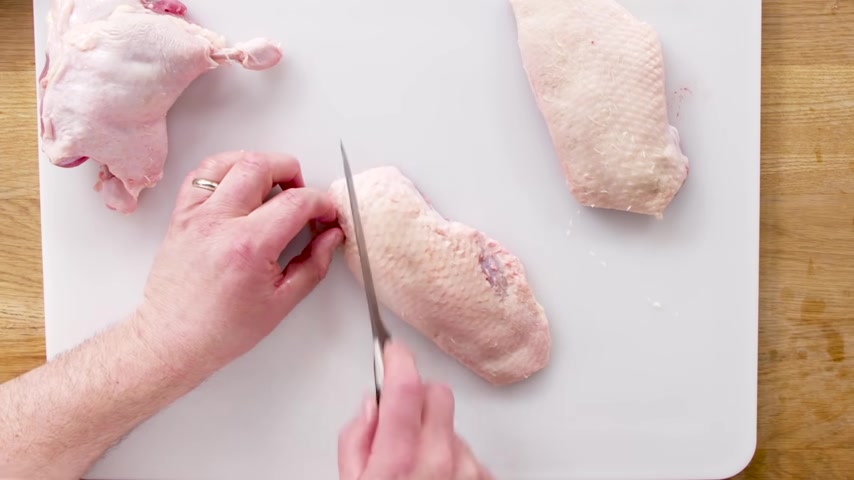
But you want to make sure your knife is nice and sharp and then we're just gonna make lines barely cutting the skin .
I'm just dragging a knife over lightly .
I don't wanna cut it too much .
Being careful to try and space these out evenly because we want it to look good .
Turn it the opposite way , we'll score the opposite way .
Just barely dragging it across .
You'll have a little bit of a diamond pattern .
This will also let the fat drain out and get your skin super crisp .
So we'll score the other one and that's our scored duck breast .
Goose scourge of golf courses everywhere .
Traditional holiday treat .
You don't see a lot of them around anymore .
Goose is a waterfowl .
It's a little gamey .
It's got nice red meat .
It's super fatty as well .
Any time you get a bird that is not only migrating but swims in the water , they're gonna have a lot of fat just to keep them warm .
There's a lot of neck skin .
The geese have very long necks .
So the one cut I'm gonna do is take some of that neck skin off .
We're trusting it .
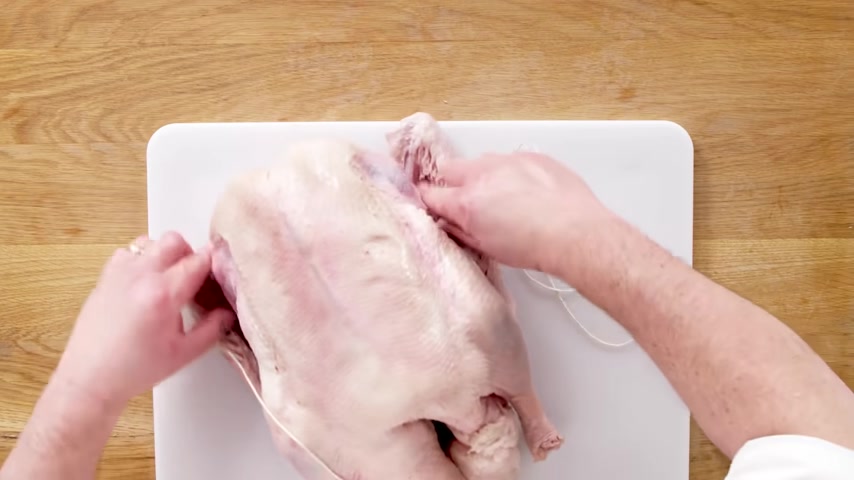
I'm gonna give myself some butchered people will call this string but it's not string .
It's butcher twine , it's heavy cotton string basically .
And I'm gonna give myself more than I think I need .
It's a big bird .
First thing I'm gonna do is take the wings and tuck them under .
Right .
We tuck the wings under like this .
So the wingtips don't burn .
Let's grab our butcher twine , tuck this under the breast and over the wing , come on the outside of the legs , make a cross .
We're gonna fold down and then fold down again on the outside , pull tight and then tie and then I'm gonna complete my knot .
Take off the excess of the twine adjust so that this is under the thigh .
Everything's nice and tight .
Now , technically , this isn't a butchering technique , but it is a technique a butcher will do for you .
This tying will make the bird kind of more compact .
So it'll cook more evenly .
Not only that , it'll make the bird pretty .
It's gonna hold the bird together .
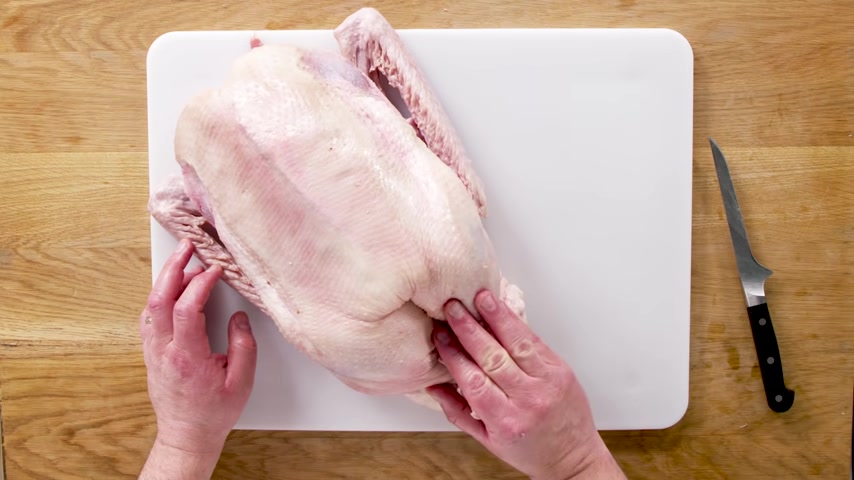
The legs are gonna be held up tight to the breast .
They're gonna cook really evenly .
And then , uh , when we take this out of the oven , the legs will stand up and look really pretty .
This is my trust goose .
Throw it in the oven with a bed of vegetables .
You'll have some nice gravy and a beautiful goose .
Capon .
Capon's a young rooster that's been castrated .
It's less energetic .
So it doesn't run around a lot .
It develops larger breasts that are super juicy and flavorful .
It's not super gamey , but it's a little more gamey than a chicken .
We're gonna break this Capon down into three parts , a front half and then two legs and thugs .
I'm gonna take the wings tuck them under so they get out of our way .
This will help hold the roast up as well .
And then what I'm gonna do is I'm just gonna cut by the legs and just free the legs up a little , just so the skin kind of falls down , open it up a little and then I'm gonna take my knife cut through the ribs all the way down to where the spine is once I get down to the ribs , I take this front half and the back half and crack it apart .
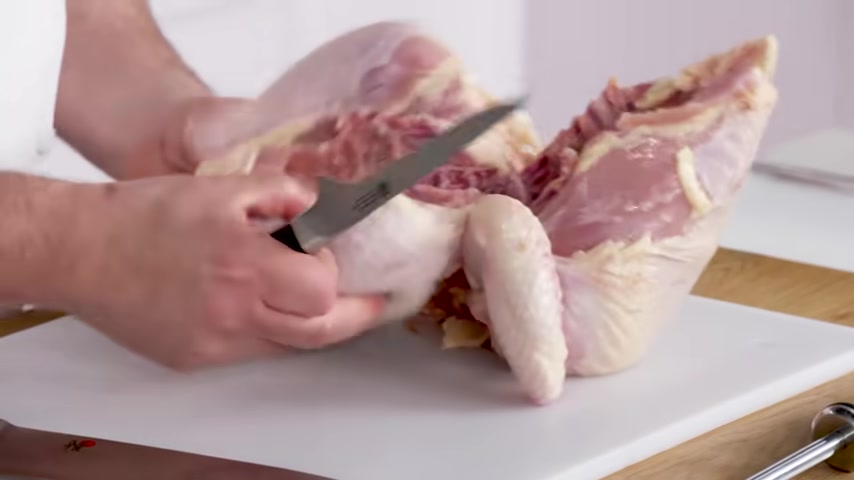
It's gonna break the spine and it's gonna give me a nice clean line .
I can run my knife through .
So my knife doesn't have to cut through bone .
Ok ?
So now we have our front half breasts and then our back half legs and thighs .
Now we're going to take the legs , the back part off .
There's a little bit of a bone here sticking out , get under that bone free up the legs , pop out the ball joints or the joints , the sockets there and then we'll just cut the thigh meat off .
Same thing on this side , make sure you get that little oyster there cut in and then just follow the line down .
So we have our legs and thighs and then our front half , we're gonna roast this all together and then once the breast hits kind of our target temperature , we'll take it out .
So it doesn't get dry and you'll have happy guests a quail .
You can find at a butcher shop or you can hunt for it .
A lot of times you'll see these partially boned out with the breast meat taken off the bone and the breast bone taken out in the back .
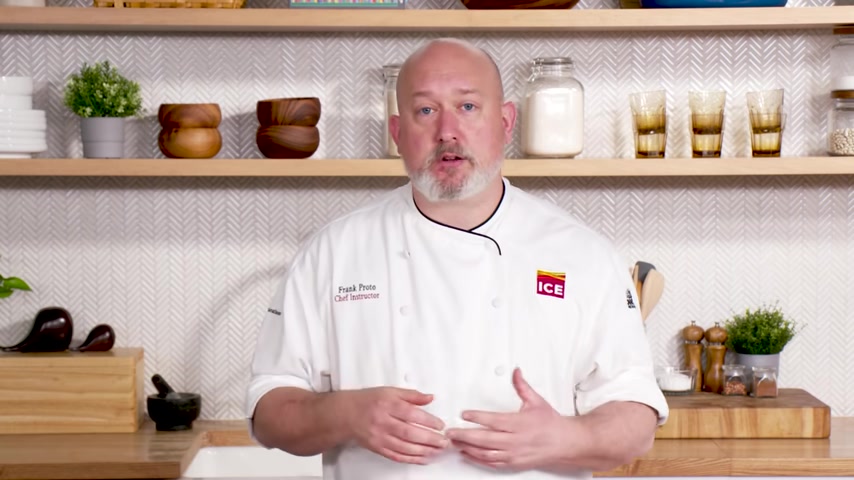
And for the most part , when we use these in restaurants , they are served with the leg and the wing bones in the flesh is tender .
It's mild , it's not super strong and , and what we're gonna do today with the quail is we're gonna make it semi boneless .
We'll leave the leg and thigh bones in the wing bones in and try and leave the breast without any bones .
And by taking the breast and the backbone out , it's just easier to get at this because it's a small bird .
You gotta be really delicate with it .
So I'm just gonna cut around the neck meat and just get rid of that neck .
It's just gonna be in my way .
I don't need it and then I have to get under the skin .
I'm gonna use my pinky .
I still have chubby fingers , but if you have skinny fingers , you're better for this , right ?
But I'm just gonna loosen up that skin and try not to break it right .
So I'm gonna push down and loosen up that skin as much as I can all the way down and around the breast .
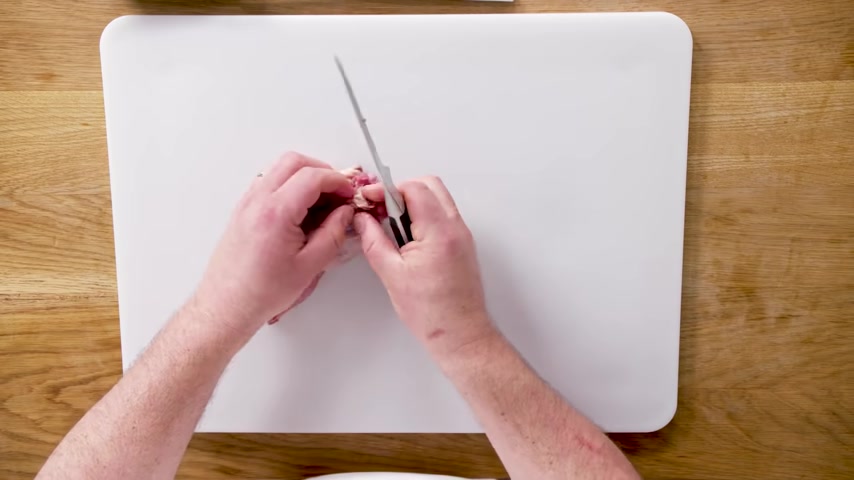
I want the skin to kind of be free , try and get on the bottom now and the wing joint here , I'm just gonna expose that , stick my knife through and get through the wing joint and just free up that wing joint so that the breast is no longer attached to it .
Same thing on this side free up that wing joint .
So now you can see that our wings are free .
I'm gonna go down the back again with my finger and try and free up as much skin from the back as I can because I really wanna do this kind of like take this off like a sock , right ?
So I'm just gonna try and be as careful as I can to not tear the skin at this point .
You can see why these birds would be a little more expensive because it takes a little more time to process them .
I'm gonna roll it out like a sock .
Try and be as careful as I can not to tear .
Ok , take the breast off with my knife .
Can I just leave the breasts hanging right there ?
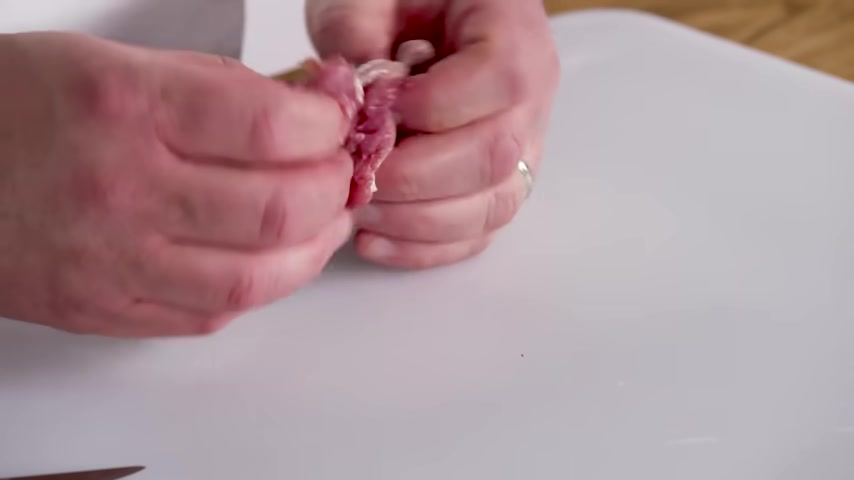
Cut behind here , detach whatever is holding that together , right ?
Expose the backbone here and just cut through that bone , pull the breasts and the carcass away from each other and then basically unroll tuck the breast back in and unroll the skin over the top .
This is my semi boneless quail .
We took out the breast bone and the back bone from the top half of the bird and we left the wing and the leg bones in when we cook this , it's gonna pretty much hold together like it is when you uh pull the legs off , you can chew on the legs , get the meat off the bone .
Uh and then you'll just kind of pull the wing side off and eat the breast in kind of a nice big chunk guinea hen .
So guinea hen is kind of , uh , the entry level game meat .
It is a little more flavorful than chicken , but not necessarily as flavorful as a squab or maybe a duck or a goose .
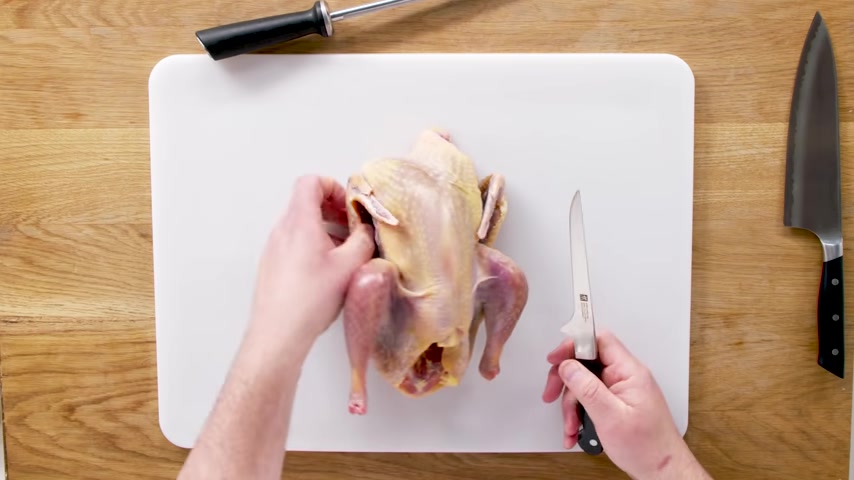
So , if you're gonna just like dip your toe in , get yourself guinea hen , we're gonna cut this bird in half , one half is gonna have the bones in the other half is gonna have the bones out .
And for this , I'm gonna take the wings , uh or at least the flats off , cut really close to the breast .
And then I'm gonna run my knife down , kind of run my knife along the bone .
So you hear the bone scraping and I'm just gonna pull this back , try and get off some of that cartilage and pull off that wing meat .
So we have a decent like clean bone for that .
Ok .
So we'll do that to both sides with this .
I usually get my chef knife hit it with the edge , pop off that bone .
So it's nice and clean or that pop off that joint .
The first thing we're gonna do with this is cut off the meat from one side , just cut along that breast bone cut through here .
Spin the guinea hen around .
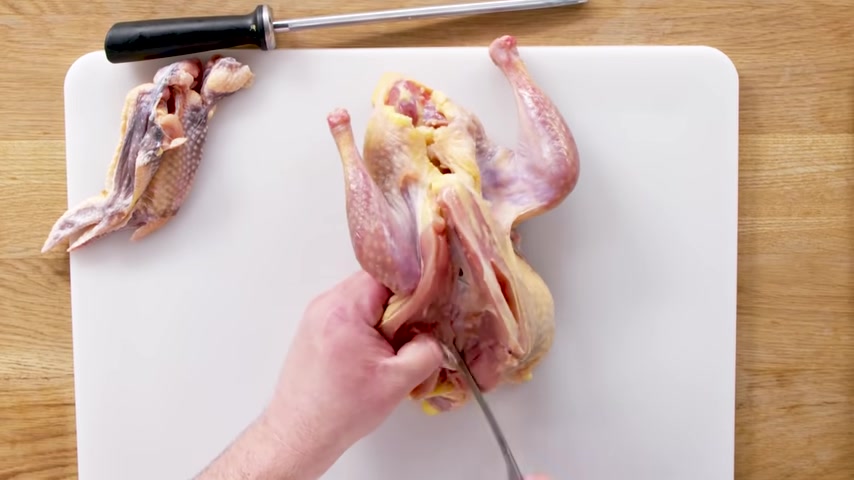
Follow that nice line where the breast comes off , cut all the way through to where the cavity where the leg meets the carcass , pop that joint out cut through .
Make sure we get that oyster pull this little wing bone up cut through the joint and then we have the side of the bird that comes off .
We'll put this aside for a second .
We have that little wing joint here .
The only bone it's really going to have is the wing bone .
So I'm gonna get my pointer and my thumb spread this meat out and just follow along or trace along the leg and the thigh on the inside and then do the same on the outside .
Pinch under the leg , cut through that leg joint , pinch under the thigh , get the thigh bone out .
Now , what I'll do is I'll hold these together , just kind of push it back and go around the joint so that I cut the leg and thigh bone out .
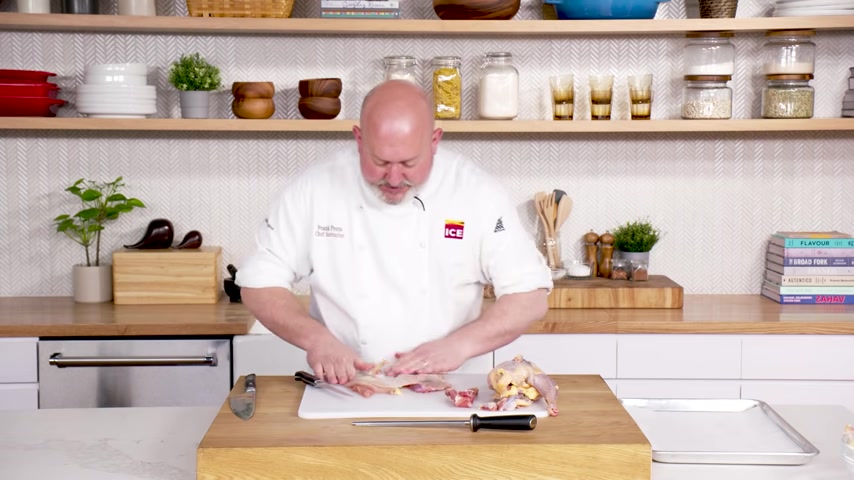
And I have a really nice half of a guinea hen with the skin intact .
It's just got this little bone .
I like to store it , fold it up and we can , now we can like either saute or roast this by itself , but the other side .
So I have a pair of kitchen chairs here , all kitchen chairs with scissors , but not all scissors or kitchen chairs .
Basically a kitchen .
She is just a little more heavy duty .
They're made for cutting through a kind of soft bone .
So what I'm gonna do with this is just cut down .
I see the little tail bone there just gonna cut down the back and then cut through the top .
And now I have my half of a guinea fowl off on the excess skin .
So that's our guinea hen on the bone and then our guinea hen off of the bone .
This is my guinea hen .
We halved it .
I boned out this half , which is great for sauteing and I left the bones in this half , which is great for roasting pheasant .
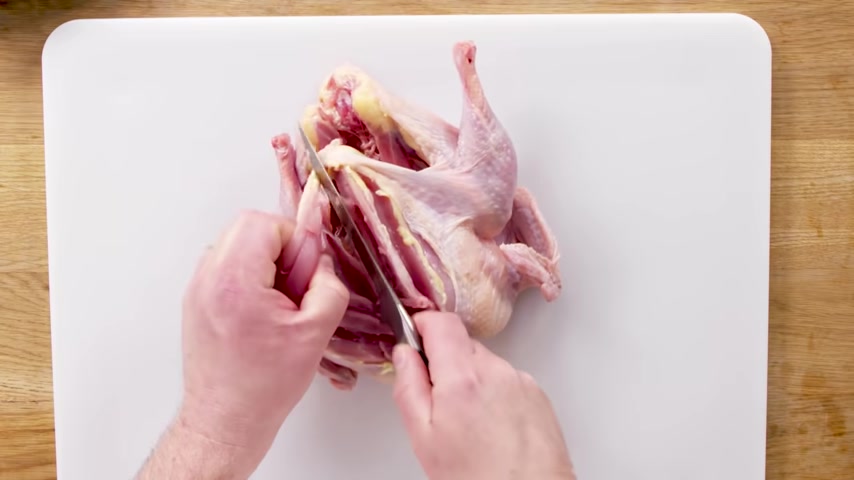
It's kind of like chicken , but a little more gamey pheasants can be hunted in the wild or it can be farm raised .
The wild ones are obviously gonna be a little more gay .
The farm raised ones will have a little less flavor , but it's basically a chicken that's a little more athletic , a little more flavor .
And it's kind of one of those game birds that isn't too gay for this pheasant .
We're gonna cut into six pieces .
Both breasts are gonna come off leaving the wing on .
We're gonna take the legs off and cut those into drums and thighs .
First , we're gonna take the breast off and the breasts on this pheasant aren't as large as a commercial chicken .
They run around a little more , they're a little more athletic and they're not bred to have big breasts .
So they're gonna be a little smaller .
And what we're gonna do with these is we're just going to take these off .
Right .
I cut through the skin here , there's a bone there .
Make sure you cut the skin tight to the leg and then I'm gonna follow the wish bone down and the wing joint is right at the end of the wish bone and we're gonna cut that off .
So that's the breast with the wing left on .
We'll do this on the other side .
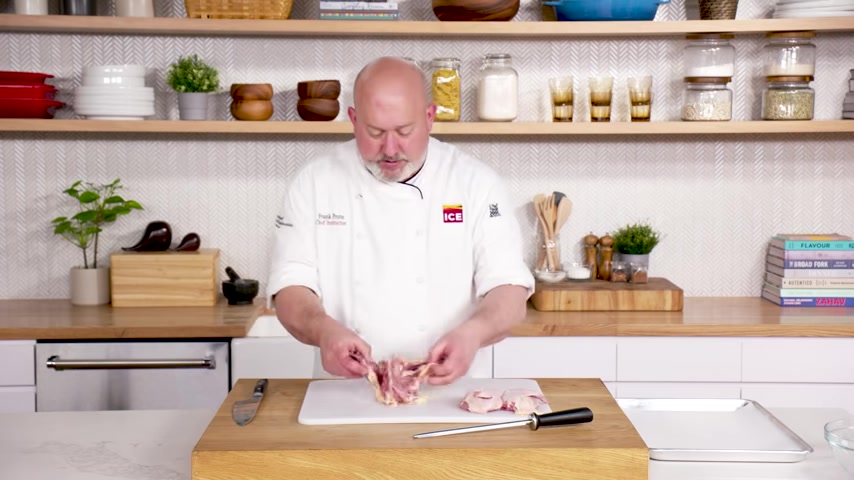
So we have two really nice breasts with the wing on for the legs .
I'm just gonna open it up a little , there's a little hip bone here , I'm just gonna cut that and free it up from there .
Like any other bird , we're gonna pop out those joints .
Or if you lift the leg up , the oyster will kind of pop out , flop it over , same thing on the other side .
But we start from the top , cut out that oyster .
So we have our legs here .
We're going to separate this out of the thigh and drum and you can see that the meat is a little darker .
The fat is a little darker as well because this bird runs around a little more and probably has a more varied diet .
It's going to be a little tastier than your normal everyday supermarket chicken .
You can always just kind of wiggle it .
And you can see that there's as Jacques Pepin says it articulation there .
And when you see where the articulation is , you can cut and separate that and if it doesn't cut , you just move it over slightly and you almost always find the joint that's the pheasant .
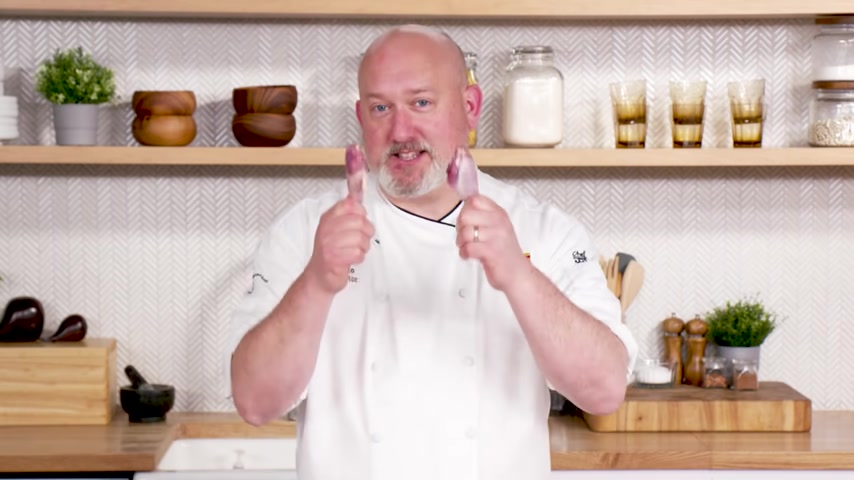
We have the breasts that we've removed from the bone we left the wing on .
These are really great for roasting or sauteing the thighs and the drums .
You can even throw on the grill if you want , but the thighs would be really good for kind of a stew or a moist he cooking and the drums .
You can deep fry , cornish game hen , kind of a misnomer .
It is not a game hen at all with game .
You're going out and hunting for it or you're trying to catch it in the wild .
This is a domesticated bird .
It's a little more delicate than chicken .
This is a young bird which usually means they don't run around a lot .
The meat is a little more subtle flavored , a little more delicate .
We're gonna take all the bones out so that we have just meat and skin .
The first thing I want to do is take off the flats and the tips of the wing .
You can save these to make hot wings with .
We're gonna turn this over and we're gonna make a nice score down the middle .
All the way to the bone .
Don't cut through the bone , right .
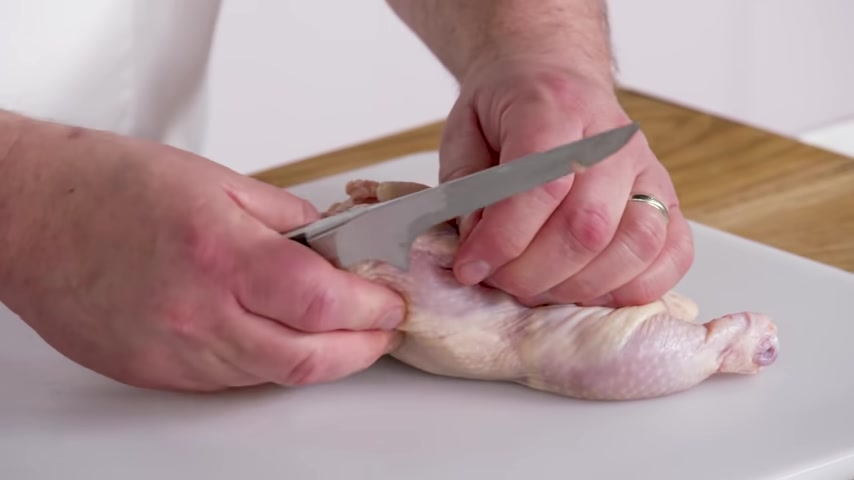
I'm just gonna free up some of the skin there , free up some of the skin there and start pulling that skin back off of the breast , exposing the joint here where the drum met meets the breast , wherever the drum met and the breast meet , we're gonna cut that all the way through and free up that meat there .
Then what we're gonna do is I'm gonna get my finger in there and pull this down and back .
Basically , just pulling this directly off of its gonna use our hands and get those breasts off .
We're gonna take out the tenders as well .
Those will go back in when we roll this up and now we're gonna free up the legs and thighs .
So we're gonna just pop those out , pop the joints out .
Grab our oysters , make sure we get those oysters in there .
And then we're just gonna cut through that leg joint , turn it around , cut through that leg joint again .
And we're just gonna pull this and that comes out right .
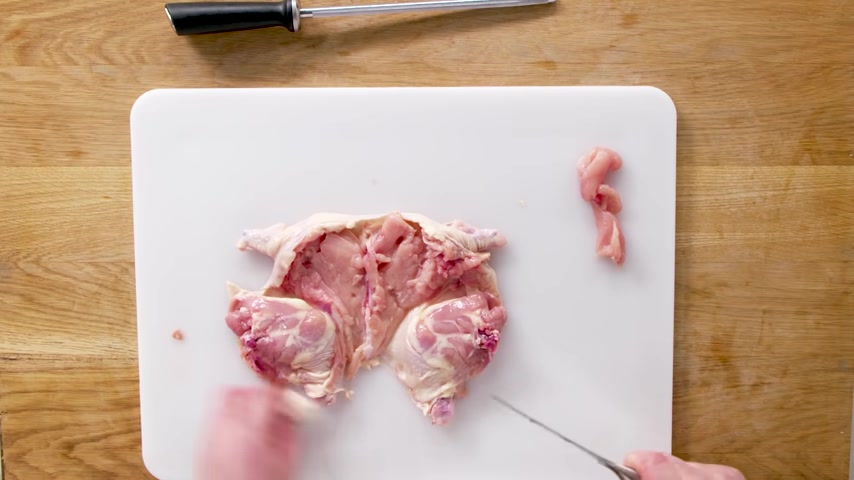
So now we have the cornish hand that's mostly boned out .
If there's a little piece of cartilage here , this is called the keel bone .
If it's left , we can pull that out because we don't want the cartilage in there .
So now we have our cornish hand , our skin is intact .
I'm gonna get any of the extra kind of skin .
Get rid of that .
Now , I'm gonna take the leg and thigh bones out , stretch the , the meat , pull it away from the bone , cut on either side , pinch between the bone and the meat and cut it off and just gently remove the meat from the bone .
And that's our leg and thigh bone .
Let's get the other side off , stretch the meat out and there's our other leg and thigh bone .
So now we have this mostly boned out .
I'm gonna take the little drum mets off now too because we want this to be basically boned out .
We have our two little drums .
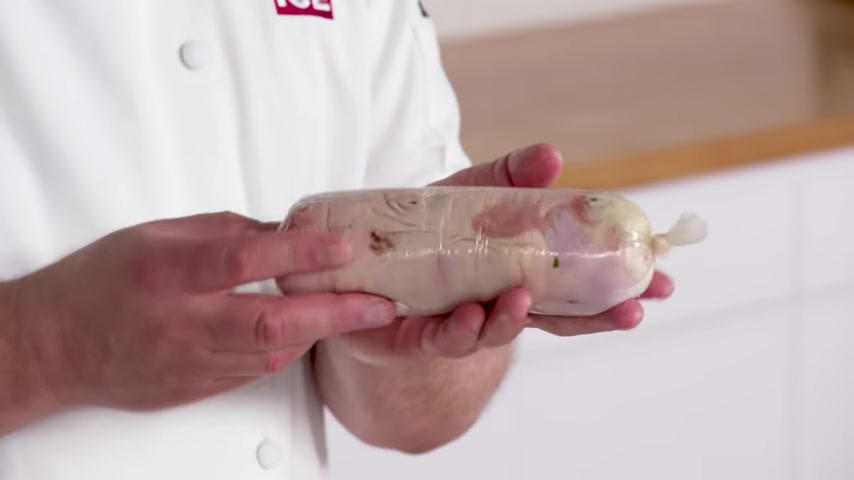
You could fry these up for chicken wings and now our cornish he is totally boned out skin intact , just make sure , uh , there's no excess bones floating around in there because you want this to be totally boneless .
So I just like to poke around .
Make sure there's no little shards of anything .
OK ?
We have our two little tenders here .
I just kind of put them in where there's loose skin .
We have a musin style force meat , which is chicken meat , cream eggs , some seasoning , some parsley .
And now we're gonna roll this into a which is just a roll .
We're just gonna roll it up , make sure it's not squeezing out .
Put it over here , get your plastic wrap , plop this on there and just roll .
We're gonna tie it one side , cut off our excess plastic and now we're just gonna tie this other side .
So it's fairly tight .
If you can put it in some simmering water or you can just grill the whole thing and slice it or saute the whole thing and slice it .
It's a little fancier than if you just roast the whole bird .
So you're gonna impress your in-laws with this one .
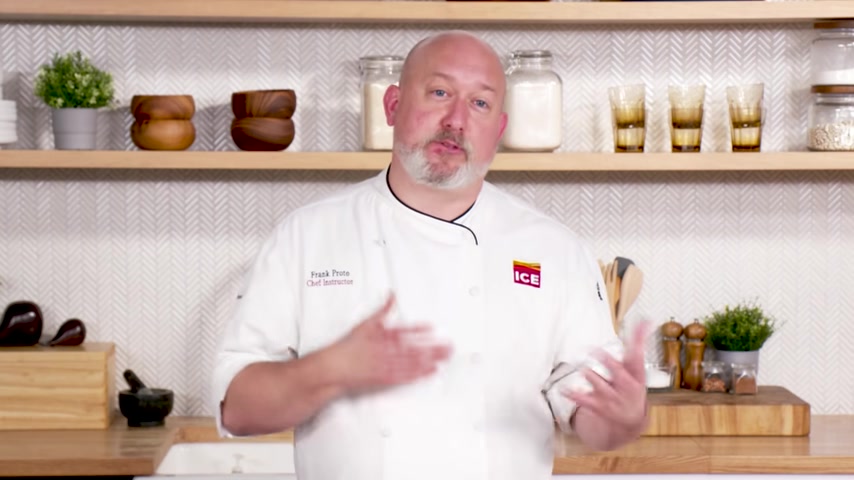
This is our de bone stuffed and rolled cornish head .
Go long squab .
A swab is a young pigeon that has never flown .
And this isn't like the pigeons you find on the street .
This is a pigeon that was basically raised on a farm .
These are fed well , they don't pick through garbage .
So it's delicious for this swab .
We're going to get two airline breasts or two supreme of squab breast , airline breast or Supreme are kind of interchangeable .
It just means the really nice part of the breast .
The best cut of the bird , one breast .
I'm just gonna leave this little wing joint on with all the meat .
The other one , I'm gonna take it off and try and clean the bone with the one that I'm gonna leave the meat on .
I'm just gonna find that joint here and cut the wing and the flat off .
You can use this for gravy , you can cook it and make little fried wings with it .
You can use it for stock as well .
But for our purposes today , we'll just put it aside for the other side .
I'm gonna try and clean that bone off .
I let the breast face me .
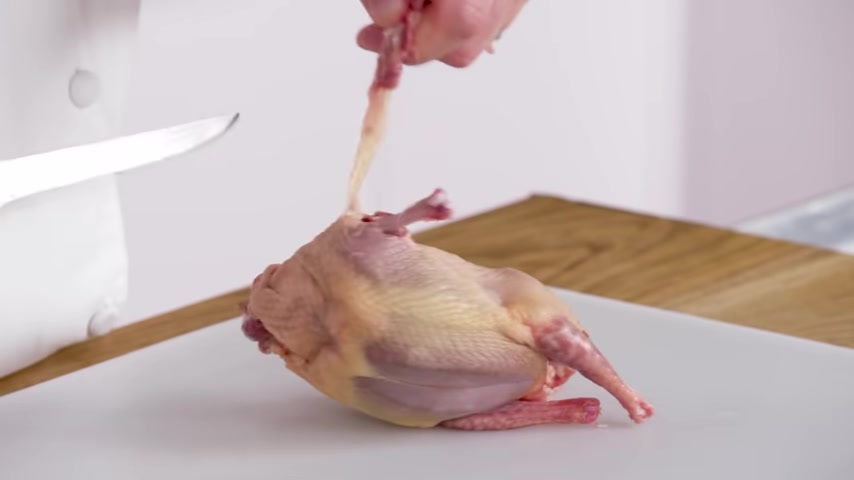
I'm gonna stretch the wing out and kind of like really get that muscle to kind of like contract .
I press my knife on the breast side .
I cut straight down to the bone and then I'm gonna drag my knife across the bone until I hit the cartilage .
And then I'm gonna bend this back .
Push the bone away and we get a nice clean bone here .
I wanna grab my chef knife for this and just take this , put it on the edge of the bone , give it a little pop , right ?
And we have a really clean piece of bone there .
So you'll see when you say airline breast , that little joint was left on to make it look like there was more bird than there actually was on the plate where you can get it nice and clean , which look you like better .
Ok ?
So now we're going to take the breast meat off .
I like to pull the legs out a little just to give a little extra skin to the bre , we're gonna separate the legs out .
The legs are edible and they're delicious , but there's so little meat on them .
We're just gonna worry about the breasts here .
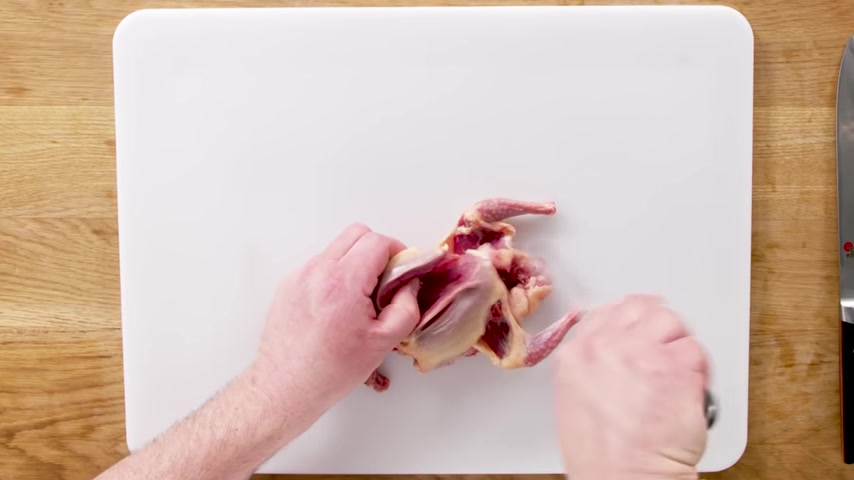
Find the breast bone cut on either side of the breast bone .
We're gonna take our knife here , just get the tip in there and run it across the carcass .
Follow that wish bone once we hit the wish bone , that's where the joint is for the wing and we take the breast off with the little wing joint attached .
So that's our one airline or c right there .
Same thing on this side .
Follow down the wish bone , cut it off and we have our nice little Supreme with that drum Mets still on .
Clean them up .
Make them look pretty So either one of these can be called the Supreme or an airline breast .
This drum on this one has the meat on it .
This drum has the meat taken off .
This is a little more dainty , a little more fancy .
Either way they're absolutely delicious dove .
A dove you will not see in the supermarket you won't see it at a butcher .
For the most part .
This is hunting in the American South .
It's a game bird .
You have to go out and hunt for it .
It's slightly gamey .
It's super rich .
And for the most part you don't use the legs .
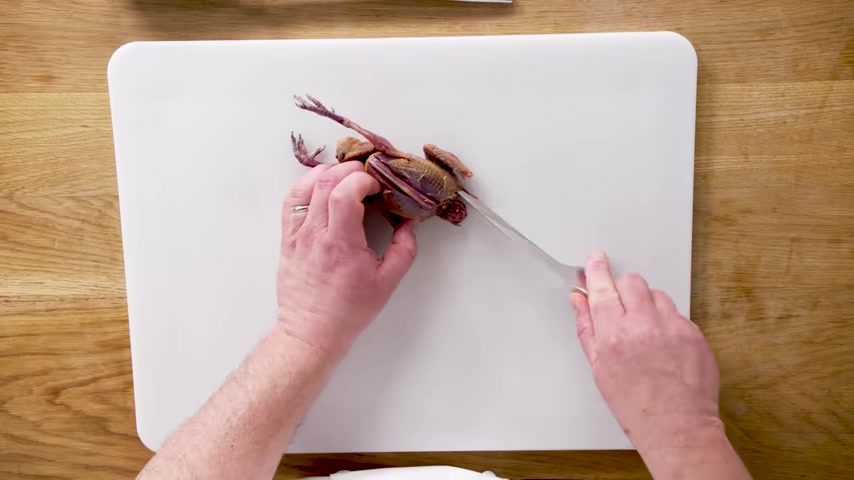
All we're gonna use is the breast on here .
So we're just gonna take it off the bone cut on either side of the breast bone , the back of my knife stays on the carcass , just run it down the wish bone and then we're gonna open it up and the breast pops right off the other breast .
We're gonna do the same thing and these are our boneless breasts of dough and there's just basically two bites out of this .
You're not gonna get a lot .
This breast meat is tender .
It's lean , it's dark .
So you don't want to overcook it .
If you overcook it usually it gets a little dry and livery .
So you want to make sure you cook this medium rare to keep it nice and moist and that's how you break down all of the birds .
Maybe not all the birds but this will show you how to deal with poultry , large , small , dark meat , light meat and make a great meal .
Are you looking for a way to reach a wider audience and get more views on your videos?
Our innovative video to text transcribing service can help you do just that.
We provide accurate transcriptions of your videos along with visual content that will help you attract new viewers and keep them engaged. Plus, our data analytics and ad campaign tools can help you monetize your content and maximize your revenue.
Let's partner up and take your video content to the next level!
Contact us today to learn more.